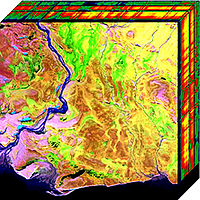
Photo from wikipedia
Bruising of the subcutaneous tissues of blueberries is an important form of mechanical damage. Different levels of bruising have a significant effect on the post-harvest marketing of blueberries. To distinguish… Click to show full abstract
Bruising of the subcutaneous tissues of blueberries is an important form of mechanical damage. Different levels of bruising have a significant effect on the post-harvest marketing of blueberries. To distinguish different grades of blueberry bruises and explore the effects of different factors, explicit dynamic simulation and near-infrared hyperspectral reflectance imaging were employed without harming the blueberries in this study. Based on the results of the compression experiment, an explicit dynamic simulation of blueberries was performed to measure the potential locations of bruises and preliminarily divide the bruise stages. A near-infrared hyperspectral reflectance imaging system was used to detect the actual blueberry bruises. According to the blueberry photos taken by the near-infrared hyperspectral reflectance imaging system, the actual bruise rates of blueberries were obtained by using the Environment for Visualizing Images software for training and classification. Bruise grades of blueberries were divided accordingly. Response surface methodology was used to determine the effects of ripeness, loading speed and loading location on the blueberry bruising rate. Under the optimized parameters, the actual damage rate of blueberries was 1.1%. The results provide an important theoretical basis for the accurate and rapid identification and classification of blueberry bruise damage.
Journal Title: Foods
Year Published: 2022
Link to full text (if available)
Share on Social Media: Sign Up to like & get
recommendations!